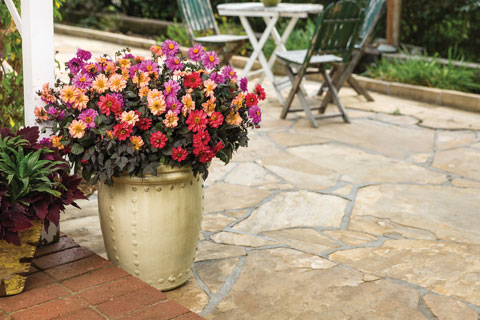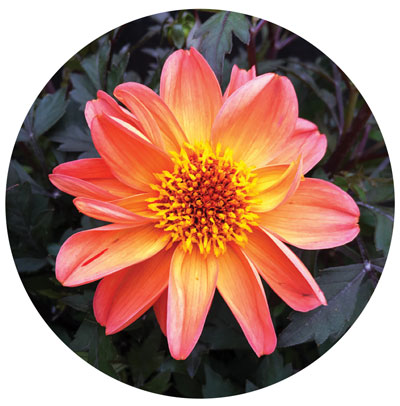4/1/2020
Growing Dahlightful Dahlias
Maria Zampini

When it comes to fashion, a little black dress is a staple in most women’s closets. And you can easily become “on trend” by simply adding accessories in whatever the “it” color is at that time. Utilizing a dark color as a backdrop helps other lighter or brighter colors stand out and be the center of attention.
Similarly, for over a decade, dark-leafed plants have grown in popularity, so plants with black, chocolate or deep merlot foliage have become a more desirable color palette in the garden. And just like with clothing, plants with dark foliage make rich, colorful flowers stand out and even more striking than if they were on green-leafed selections.
Imagine a backdrop of dark leaves, add in prolific, gorgeous blooms all summer long on a compact, dense growing plant that’s tolerant of most powdery mildew strains, withstands the heat and is a butterfly magnet, and what have you got? Dahlightful Dahlias—but more importantly, “dah-lighted” growers and gardening consumers.
 The Dahlightful Dahlias are a dark leaf, genetic breeding breakthrough in that they perform well in the landscape or in containers as a premium annual. And, with their rich, jewel-toned flowers contrasting against chocolate foliage, they’re a perfect alternative to mums or zinnias for a late summer/early autumn grab-and-go solitary or mixed pot choice on retail shelves as consumers start thinking fall.
The Dahlightful Dahlias are a dark leaf, genetic breeding breakthrough in that they perform well in the landscape or in containers as a premium annual. And, with their rich, jewel-toned flowers contrasting against chocolate foliage, they’re a perfect alternative to mums or zinnias for a late summer/early autumn grab-and-go solitary or mixed pot choice on retail shelves as consumers start thinking fall.
Pictured right: Dahlightful Georgia Peach Dahlia.
The Dahlightfuls are currently available in five colors, including Georgia Peach, Lively Lavender, Crushed Crimson, Sultry Scarlet and Tupelo Honey. There are more Dahlightfuls on the horizon with six selections in final trials across the U.S. and Canada.
One of the goals for Dahlightful Dahlias breeder Rick Grazzini of Garden Genetics was easy production. Plants are exceptionally resistant to most powdery mildew strains and are well adapted to growing in most of the United States and Canada. Below are the tips and tricks Rick shares to be successful in producing Dahlightful Dahlias.
Culture details
• pH: 5.8 to 6.2
• EC: (2:1 Extraction method) 0.8 to 1.2
• Light: Dahlias are a high-light crop for best growth and heavier flowering.
• Daylength: Provide night interruption for four to six hours from September through March (Week 15) to increase vegetative growth, prevent tuber formation and promote flowering. Day extension may also be used to maintain 14-hour daylength or more.
• Temperature: 65 to 72F (18 to 22C) rooting and growing on; hold at 50 to 60F (10 to 15C)
• Scheduling: Propagation takes three weeks for rooting. Finishing takes seven weeks for 6-in. and gallons plus or minus, depending on season and conditions; 8-in. pots: nine weeks; 10- to 12-in. pots: 10 to 12 weeks
• Pinching: Pinch one to two weeks after transplanting; large pots over 6 in. may require another pinch
• PGRs: Dahlightful Dahlias are naturally somewhat compact, but B-Nine may be used, especially in smaller containers at 1,250 to 2,500 ppm; trial first before widespread application
• Pests: Spider mites, thrips, aphids, whitefly and leaf miner can be problems; scout frequently and treat quickly if a problem appears.
• Disease: Pythium and Rhizoctonia can be problems, so a preventative program is best. Avoiding stress such as high salts is a good starting point. A program that can be utilized:
1. After transplant, drench with Fluopicolide (e.g,. Adorn) + Fludioxonil (Medallion)
2. At final spacing, drench with Cyazofamid (e.g., Segway) + Iprodione (Chipco 26019)
3. At visible bud, drench with Trifloxystrobin (e.g., Compass O) + propamocarb hydrochloride (Banol)
For Powdery Mildew, strobilurins (e.g., Heritage) work well. Always follow label instructions carefully. Test on a small portion of the crop prior to widespread application.
Key items to focus on
• Dahlias are long-day plants. They must have 14-hour days or night interruption lighting to grow and flower well, otherwise they form tubers and slow down.
• Avoid holding in liners too long. Transplant when rooted to maintain active growth.
• Dahlias are salt sensitive. Feed at 100 to 200 ppm N; use a low ammonium fertilizer and irrigate thoroughly to avoid salt accumulation. And avoid severe dry-down, as this encourages salt damage to the roots, permitting disease development.
• Dahlightfuls are resistant to diseases, but watch closely and scout often for insects as well. GT
Maria Zampini is President of UpShoot, LLC.